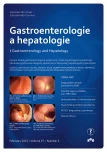Acute gastrointestinal bleeding and changes in lipid profile – pilot project
Authors:
V. Hrabovský 1; A. Mendlová 2; Z. Zadák 3; V. Bláha 4; R. Hyšpler 4; A. Tichá 4; Z. Švagera 5
Authors‘ workplace:
Interní klinika LF OU v Ostravě a FN Ostrava
1; Metabolická JIP, FN Ostrava
2; Centrum pro vědu a výzkum, LF UK v Hradci Králové
3; Klinika gerontologická a metabolická, FN Hradec Králové
4; Ústav biochemie, FN Ostrava
5
Published in:
Gastroent Hepatol 2013; 67(1): 30-36
Category:
Clinical and Experimental Gastroenterology: Review Article
Overview
Purpose of the study:
The aim of this pilot study was to describe changes in lipid metabolism in patients with acute gastrointestinal (GI) bleeding and to assess possible influence of hemodilution and changes in the cholesterol synthesis/absorption process.
Material and methods:
In 12 patients with gastrointestinal bleeding, the levels of lipid metabolism (total, LDL and HDL cholesterol and triglycerides) were determined on days 0, 3 and 6. On the same days, levels of the cholesterol synthesis indexes (lathosterol, squalene) and absorption (campesterol, sitosterol) were determined. The results were evaluated in comparison with the control set, and cirrhotic and non-cirrhotic patients were compared. At the same time, correlations of lipids and haemoglobin, hematocrit levels anduse of transfusions were evaluated.
Results:
The patients had significantly lower levels of total cholesterol (p < 0.001). Decrease of LDL and HDL cholesterol was not significant. Concentrations of triglycerides were normal. Decrease of lathosterol was significant (p < 0.05), but decrease in squalene, campesterol and sitosterol levels was insignificant. Comparing patients with cirrhosis and without cirrhosis showed statistically significant difference in levels of cholesterol and lathosterol (p < 0.05). Correlations did not show any statistically significant findings.
Conclusion:
In patients with acute GI bleeding, changes is lipid metabolism including alteration of the process of synthesis and absorption were proved. Therefore, hypocholesterolemia cannot be explained by blood loss only. However, more detailed studies need to be carried out.
Key words:
gastrointestinal hemorrhage – lipids – cholesterol – triglycerides – sterols
The authors declare they have no potential conflicts of interest concerning drugs, products, or services used in the study.
The Editorial Board declares that the manuscript met the ICMJE „uniform requirements“ for biomedical papers.
Submitted:
10. 9. 2012
Accepted:
30. 1. 2013
Sources
1. Dunham CM, Chirichella TJ. Attenuated hypocholesterolemia following severe trauma signals risk for late ventilator-associated pneumonia, ventilator dependency, and death: a retrospective study of consecutive patients. Lipids Health Dis 2011; 10: 42.
2. Vyroubal P, Hyspler R, Tichá A et al. Disturbance of synthesis of cholesterol and its precursors in clinically serious conditions. Vnitr Lek 2011; 57(5): 441–450.
3. Kuksis A. Plasma non-cholesterol sterols. J Chromatogr 2001; 935(1–2): 203–236.
4. Giovannini I, Chiarla C, Giuliante F et al. Hypocholesterolemia in surgical, trauma, sepsis, other conditions and critical illness. In: Kramer MA Trends in cholesterol research. Nova Biomedical 2005; 137–161.
5. Bonville DA, Parker TS, Levine DM et al. The relationship of hypocholesterolemia to cytokine concentrations and mortality in critically ill patients with systemic inflammatory response syndrome. Surg Infect 2004; 5(1): 39–49.
6. Hudgins LC, Parker TS, Levine DM et al. A single intravenous dose of endotoxin rapidly alters serum lipoproteins and lipid transfer proteins in normal volunteers. J Lipid Research 2003; 44(8): 1489–1498.
7. Feingold KRI, Staprans RA, Memon AH et al. Endotoxin rapidly induces changes in lipid metabolism that produce hypertriglyceridemia: low doses stimulate hepatic triglyceride production while high doses inhibit clearence. J Lipid Res 1992; 33 : 1765–1776.
8. Straube S, Tramèr MR, Moore RA et al. Mortality with upper gastrointestinal bleeding and perforation: effects of time and NSAID use. BMC Gastroenterol 2009; 9: 41.
9. Machytka E, Ehrmann J, Svoboda P et al. Incidence krvácení do horní části zažívacího traktu v regionu Ostrava-Poruba v letech 2002-2005. Čes a Slov Gasttroenterol Hepatol 2007; 61(3): 124–128.
10. Dítě P, Novotný I, Kroupa R et al. Akutní nevarikózní krvácení do horní části trávicího traktu. Čes a Slov Gastroenterol Hepatol 2007; 61(1): 6–10.
11. Barkun AN, Bardou M, Kuipers EJ et al, International consensus upper gastrointestinal bleeding conference group. International consensus recommendations on the management of patients with nonvariceal upper gastrointestinal bleeding. Ann Intern Med 2010; 152(2): 101–113.
12. Svoboda P, Konečný M, Hrabovský V et al. Přínos centralizace péče o pacienty s akutním krvácením do horního trávicího traktu. Vnitř Lék 2012; 58(3): 191–195.
13. Giovannini I, Boldrini G, Chiarla C et al. Pathophysiologic correlates of hypocholesterolemia in critically ill surgical patients. Int Care Med 1999; 25(7): 748–751.
14. Bakalar B, Zadak Z, Pachl J et al. Hypocholesterolemia after multiple injuries is not caused by simple dilution. Rozhl Chir 2001; 80(2): 67–71.
15. Bakalar B, Hyspler R, Pachl J et al. Changes in cholesterol and its precursors during the first days after mayor trauma. Wien Klin Wochenschr 2003; 115(21–22): 775–779.
Labels
Paediatric gastroenterology Gastroenterology and hepatology SurgeryArticle was published in
Gastroenterology and Hepatology

2013 Issue 1
- Metamizole vs. Tramadol in Postoperative Analgesia
- Metamizole at a Glance and in Practice – Effective Non-Opioid Analgesic for All Ages
- Possibilities of Using Metamizole in the Treatment of Acute Primary Headaches
- Metamizole in perioperative treatment in children under 14 years – results of a questionnaire survey from practice
- Obstacle Called Vasospasm: Which Solution Is Most Effective in Microsurgery and How to Pharmacologically Assist It?
Most read in this issue
- Segmental portal hypertension
- Current opinion on the therapy of perianal fistulas in patients with Crohn’s disease
- Perforated gangrenous cholecystitis
- Dysfunction of upper gastrointestinal tract in critically ill patients: current view and prospects
